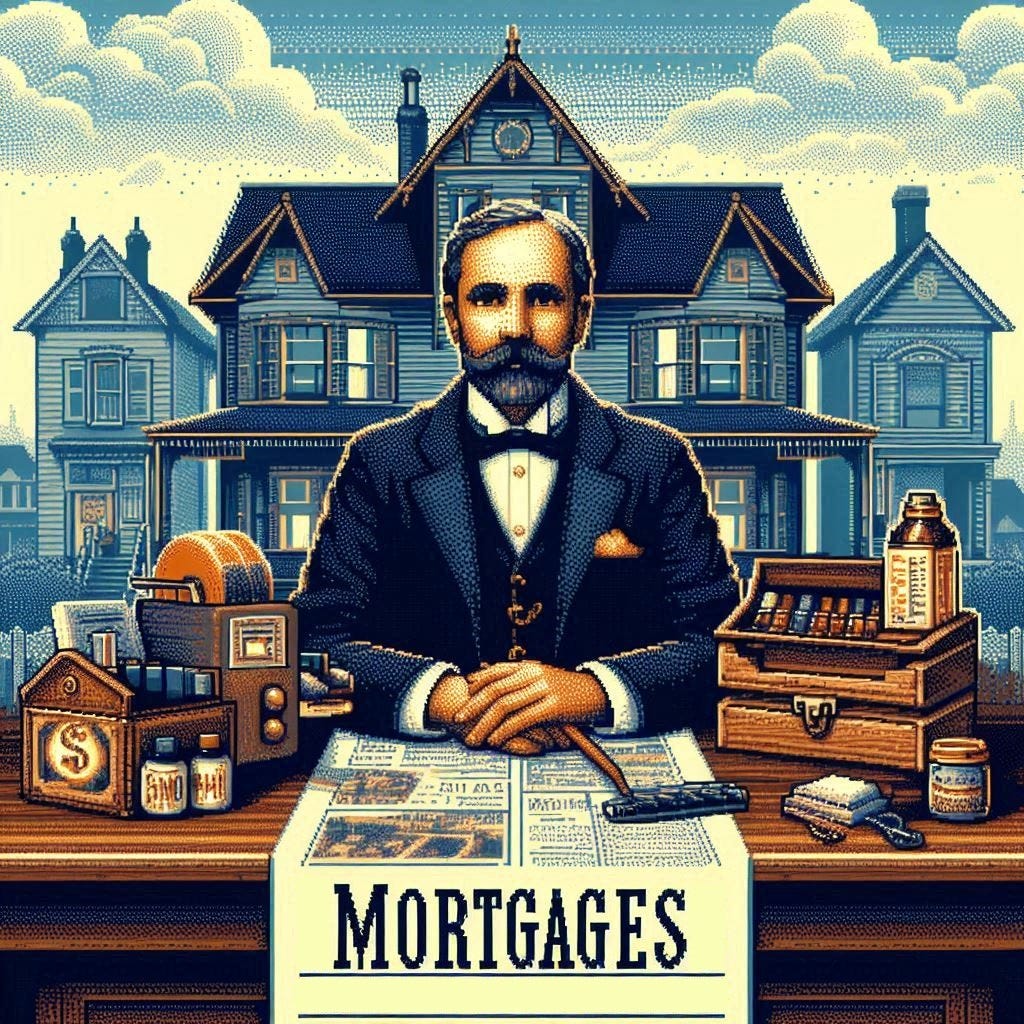The Ultimate Guide to Understanding Mortgage Rates: A Real Estate Investor's Perspective
For a real estate investor, understanding mortgages isn't just about knowing how to get a loan; it's about mastering the art of leveraging other people's money to build wealth. Today, we're diving into the mortgage ecosystem, breaking down everything from basic residential loans to creative financing solutions that can supercharge your real estate portfolio.
Let’s start with the 30-year fixed conforming mortgage. The 30-year fixed conforming mortgage is the go-to standard for beginning investors. Think of it as the vanilla ice cream of the mortgage world. This loan type offers predictable payments over three decades, with interest rates that remain unchanged regardless of market conditions. At the end of the loan, you own the property outright.
What makes it "conforming"? It meets the guidelines set by Fannie Mae and Freddie Mac, including maximum loan limits ($726K in most areas for 2024). Fannie and Freddie are the biggest stars in the mortgage galaxy. These government-sponsored enterprises (GSEs) don't provide loans to borrowers, but they buy mortgages from lenders, package them into securities, and sell them to investors. This process makes sure there is always money to borrow in the mortgage market and helps keep rates lower than they would be otherwise. These loans typically offer the most competitive rates because they're considered lower risk. When a loan "conforms" to Fannie and Freddie's guidelines, lenders can sell it to them, reducing their risk and allowing them to offer better rates. This is why you'll often see a significant rate jump when you cross into "jumbo" loan territory.
What if you need to borrow more? When your needs exceed the conforming loan limits, you're entering jumbo mortgage territory. These loans are the heavyweight champions of the mortgage world, designed for luxury properties and high-cost areas. Jumbo mortgages typically come with stricter requirements: higher credit scores, larger down payments, and higher cash reserve demands from borrowers. While traditionally carrying higher rates than conforming loans, in recent years the gap has narrowed, and sometimes jumbo rates can be competitive with or even lower than conforming rates. The trade-off? These loans are held by banks rather than sold to GSEs, making them more sensitive to individual bank appetites and market conditions.
There are many factors besides the amount borrowed that influence the rate at which the market will lend you the money. The relationship between the number of units in a property and interest rates tells a fascinating story of risk and reward in real estate lending. Banks view each additional unit as another layer of complexity and potential risk, which creates a stepping-stone effect on interest rates. Picture a single-family home as your baseline. Single family homes represent the simplest form of residential real estate and thus commands the most favorable rates. Add a second unit, and you're asking the bank to consider not just one living space but two sets of tenants, two sets of potential maintenance issues, and two streams of income. This complexity bump typically costs you an extra quarter to three-eighths of a percent in interest. The story continues with three-family properties, where managing multiple tenants and maintaining larger structures pushes rates up another notch in the same range. By the time you reach a four-family property, you're looking at rates that can climb up to a full percentage point higher than their single-family counterparts. This rate ladder reflects not just the increasing complexity of management but also the bank's view of these properties as hybrid investments – not quite residential, not quite commercial, but somewhere in between. Smart investors often find that sweet spot between the higher rates and the increased cash flow that comes with more units, turning this rate scaling into a calculated part of their investment strategy.
It’s not all bad news though, while many factors increase your rate, there are a couple that will reduce your rate. Banks love residential owner-occupants. Why? Because people tend to take better care of properties they live in. This translates into lower interest rates – often 0.375-0.75% lower than investor rates. Beginner investors often use this to their advantage by living in one unit while renting out the others, often called house hacking.
Another way to reduce your interest rate is to buy it down. Buying down your rate is like paying for a discount on your interest rate. Each "point" costs 1% of your loan amount and typically reduces your rate by 0.25%. Many banks will let you pay up to 4% of your loan to reduce your interest by 1%. That means it takes a little more than 4 years to break even. For the twenty-five and a little of the remaining years, you save a full 1% on your interest rate. Thats a lot of money. The math on whether this makes sense depends on how long you plan to keep the loan. The longer you hold the loan, the more beneficial it becomes to pay points to reduce the interest rate.
In the world of mortgage lending, your credit score serves as your financial reputation's calling card, telling a story that lenders translate directly into dollars and cents. Think of it as a financial performance scale, where 740 marks the summit of creditworthiness. At this peak, you've earned the golden ticket to the best interest rates the market has to offer. But here's where the story gets interesting – every 20-point descent from that 740 summit comes with a price tag, typically an interest rate bump of one-eighth to one-quarter percent. It's like climbing down a ladder where each rung costs you more money over the life of your loan. When your score dips below 660, you're entering what lenders consider risky territory, and the rate increases become more dramatic, reflecting their growing concern about your ability to manage the debt. Drop below 620, and you're essentially trying to open a door with the wrong key – conventional lenders will likely turn you away, leaving you to explore alternative financing options that often come with much steeper costs.
The dance between down payments and Private Mortgage Insurance tells a story of risk management in real estate financing. While the traditional wisdom of putting 20% down still holds true as the gold standard, lenders have created a pathway for those eager to enter the market with less cash in hand – enter PMI, the lender's insurance policy against your lower stake in the game. Think of PMI as the cover charge you pay to get into the homeownership club early, typically running between half to one percent of your loan amount annually. But here's the beautiful part of the story – PMI isn't a lifetime membership fee. As you build equity through your monthly payments and property appreciation, you can wave goodbye to PMI once you cross that magical 20% equity threshold. For many investors, especially in appreciating markets, accepting PMI can be a strategic move that allows them to enter the market sooner rather than waiting to amass a larger down payment.
There are many other types of residential mortgage, some with shorter terms, some with variable interest, some that are interest only, and many that are somewhere in between. All of these variants of residential mortgages provide different options for borrowers to find the best fit. From an investment point of view these are different loan variables that enable you to engineer the size of your monthly payment based on the amount of interest rate variability risk you are willing to take,
Once you pass the four-unit count on a property, you have left the land of conforming mortgages. With more than four units you have two options, a traditional commercial mortgage or debt service coverage ratio (DSCR) mortgage.
In the evolving landscape of real estate investment, DSCR loans emerge as a departure from traditional lending. While conventional lenders scrutinize your personal financial story using the W-2s, tax returns, and monthly obligations, DSCR lenders focus on a simpler metric: the property's ability to pay for itself. It's a shift in perspective that has revolutionized how investors scale their real estate portfolios. For real estate entrepreneurs, especially those who've strategically minimized their taxable income, this approach is nothing short of revolutionary. It's as if the property is applying for its own mortgage, standing on its own merits rather than yours. Of course, this independence comes at a price. DSCR loans typically demand interest rates about one to two percentage points higher than their conventional cousins. They often require heartier down payments, usually 20-25% of the purchase price, and lenders like to see some higher cash reserves in the bank, typically enough to cover 6-12 months of payments. But for many investors, these costs are merely the price of admission to a much larger game.
Unlike their residential cousins, commercial mortgages dance to a different rhythm – one that's less about standardized checkboxes and more about the art of the deal. The first thing you'll notice about commercial mortgages is their shorter lifespans. While residential loans stretch comfortably over three decades, commercial loans typically package themselves into 5, 7, or 10-year terms. But here's the twist – these loans are usually amortized over 20 or 25 years, creating what's known as a balloon payment at the end of the term. Imagine you're making payments as if you had a 25-year loan, but after just 10 years, the entire remaining balance comes due. The balloon payment at the end of the term isn't meant to be a cliff edge; it's designed as a checkpoint. It gives both lender and borrower an opportunity to reassess the property's performance, the market conditions, and the relationship. Most borrowers plan to either refinance or sell before the balloon comes due, using this structural feature as part of their overall investment strategy.
Interest rates in commercial lending tend to run higher than residential rates, typically by 1-2 percentage points or more. But this premium buys you something valuable: flexibility. Commercial lenders often prove more willing to work with complex ownership structures, unique property types, and creative business plans. They might offer interest-only periods at the beginning of the loan, giving investors breathing room to execute their business strategy before higher payments kick in.. While residential lenders focus primarily on personal income and credit scores, commercial lenders dig deeper into the property's narrative. They want to understand its operating history, the stability of its tenant base, the strength of its market position, and its potential for future performance. A property with strong financials might overcome weaker borrower credentials, while even the strongest borrower might struggle to finance a property with questionable financials.
Understanding mortgages is crucial for real estate investors. Each loan type has its place in your investing toolkit. The key is matching the right financing to your specific situation and investment strategy. Remember, creative use of these various mortgage options can help you build a robust real estate portfolio more quickly than using just one financing approach.
Keep learning, stay curious, and never stop exploring new financing options. Your next deal might require a financing solution you haven't even considered yet.
If you've found value in these insights and want to continue your journey of real estate wisdom, please subscribe to The Property Alchemist.
Don't let your real estate dreams remain just dreams. Empower yourself with the knowledge and insights that can turn your investment visions into concrete reality. Subscribe to The Property Alchemist today and take the first step towards becoming a Master of Real Estate alchemy. Your next successful project is just a subscription away!




